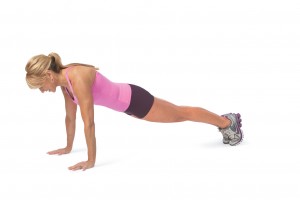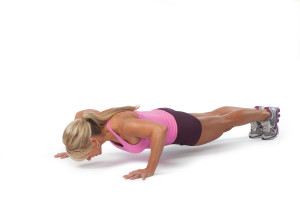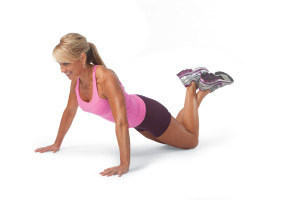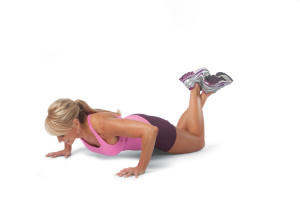I love pushups! Sorry, but I do! They are hands down one of the best upper body exercises that also challenges and sculpts your core. Actually, I need to be honest with you. The truth is…I used to hate push ups, but over time I’ve learned to love them for their amazing benefits. And push up variations helped me fall in love with them!
Same as Lift?
You might be thinking, “I do bench presses, that’s the same thing right!?” Unfortunately no…don’t convince yourself that some other exercise you’re doing is the same as doing a pushup, because it’s not. Just accept that fact that pushups have crazy good benefits and they need to be apart of your workout routine. Push ups work the whole body. From head to toe, your body kicks into overdrive to support itself and maintain a stiff straight posture – a task you don’t have to do lying on your back.
Body Parts Worked
When performing a push up, you not only work your arms, pecs, and shoulders, but you also work your core. Your core is critical to creating a well-balanced body and to gaining the strength you need to perform all exercises with great efficiency. Plus, when you have a strong core and defined upper body, you’ll stand taller, improve your posture, boost your energy, and generally look thinner than someone of the same weight with poor posture and a weak core. A strong core banishes back pain and makes all your workouts safer and easier.
Form
To get these benefits, you must maintain proper form: flat back, hands positioned under your shoulders. Different hand positions put different loads on your joints and muscles, but every one of us is put together a little differently. The way you need to place your hands to feel strongest might be slightly different than the way I need to keep my hands. So experiment with hand positions (as long as they are under your shoulders).
Keep your back flat! I’m not gonna lie, it’s challenging to do this. It forces your abs to work their hardest. But making that effort yields you the greatest results.
Modified push ups, which you do on your knees, are virtually identical to normal pushups except that the muscles are worked at a lesser intensity or overload. It’s important to maintain proper form in the modified position as well. Rest your weight slightly above the knees, keep a flat back, and activate your abs.
If you’re new to exercising start with a modified pushup and limit your range of motion. In time you’ll be able to take your chest to the floor. Each time, push yourself to go a little lower through your range of motion. No matter how frustrating it is at first, stick with it; every rep is changing your body! Push ups are tough. They’re supposed to be. But you’re tougher!
The step-by-step breakdown of push up variations below helps a ton!
Traditional Push up
1. Lie face down on your mat with your hands slightly wider than shoulder-width apart and under your chest. Keep your fingers straight and your legs straight and slightly apart with your toes supporting your feet. Your weight should be on your hands.
2. Keep your body as straight as possible, with your eyes focused straight down and your neck in a neutral position. Try to keep bottom from sinking too low or piking up. A helpful hint is from the side, you should look like your standing.
3. Lower your chest toward the floor with your arms and elbows pointing away from your body. Push up so that your arms are straight but your elbows aren’t completely locked.
4. Squeeze your glutes and brace your abdominals throughout the push up. Do not allow your lower back to sink or your hips to pike upward during the down phase.
Modified Push up
1. Get on your hands and knees, with your hands slightly wider than shoulder-width apart and in line with your chest. Cross your feet at the ankles, creating a straight line from the top of your head to your knees.
2. Keep your body as straight as possible, with your eyes focused straight down and your neck in a neutral position.
3. Lower your chest toward the floor with your arms and elbows pointing away from your body.
4. Push up so that your arms are straight but your elbows aren’t completely locked.
5. Squeeze your glutes and brace your abdominals throughout the push up. Do not allow your lower back to sink or your hips to pike upward during the down phase.
Now that you have a step-by-step on push up variations, get down on all fours and give me 20!
~ Chalene





I am having a really hard time with push ups. I never could do them, then I got stronger through Chalene Extreme and I could do them. Tricep push up I could only do on my knees. Then I had an injury, herniated disk in my neck pinching c6, c7 nerve which really messed with my left arm, destroyed my tricep muscles, the ones I had. That was October 2013, I’m still trying to recover, and lost all my strength in neck and shoulders, so no I’m having a hard time. But I’m not giving up. I started Chalene Extreme again, plus now on week 4 of piyo and while I am still weaker, I feel I am making progress slowly and getting stronger. I don’t love push up and I do them anyway, even if I have to modify.
Glad your still in the game. I can totally relate. I have a moderate herniated disc on my C5. I can tell you only strengthening the surrounding muscle groups have been the best relief for me. Early this year I was unable to do 1 single push up and now I can do them with proper form. I didn’t give up I continued to listen to Chalean’s positive encouragement. The amazing improvement did not come overnight that’s for sure but I was determined to keep going until I saw what I wanted to see. I’m on my last week of the Extreme Push phase now and she includes push ups and says that she loves them that she used to hate them. I don’t love them yet lol but do think of the benefits they bring. I did modified push ups for at least a couple of weeks before being able to do them traditionally. What I once thought impossible has now become my reality!!
I just started your PIYO program and purchased your book Push. I’m also taking the 30 day challenge. I am a little confused about the exercise plan. Can you advise where Piyo fits in to the 3 days of intense cardio, 2 days of moderate intensity and 1 day of moderate to low intensity? Should Piyo be used in addition to this schedule? I am active and fit and wanted a new fitness challenge. Thank you!
Wow! Debbie you’re amazing! Depending on your fitness level, PiYo can range from low to moderate intensity. Yes! You can definitely do PiYo in addition to this schedule. What’s so awesome about PiYo is it makes your body stronger and more flexible at the same time. Thanks for your support! Keep in touch 🙂